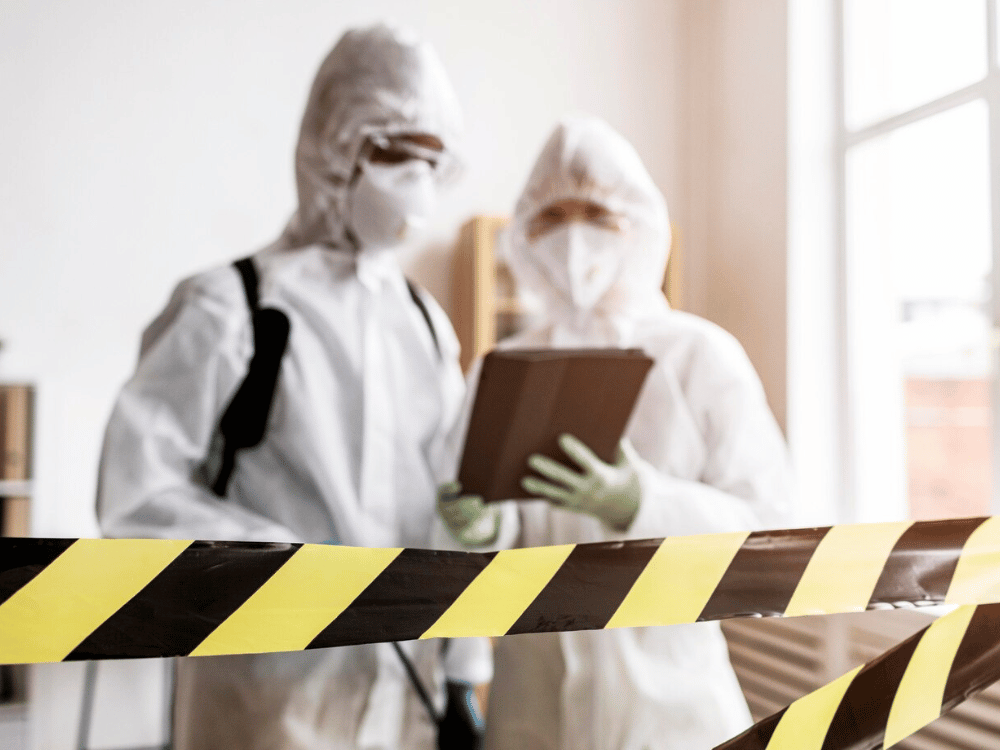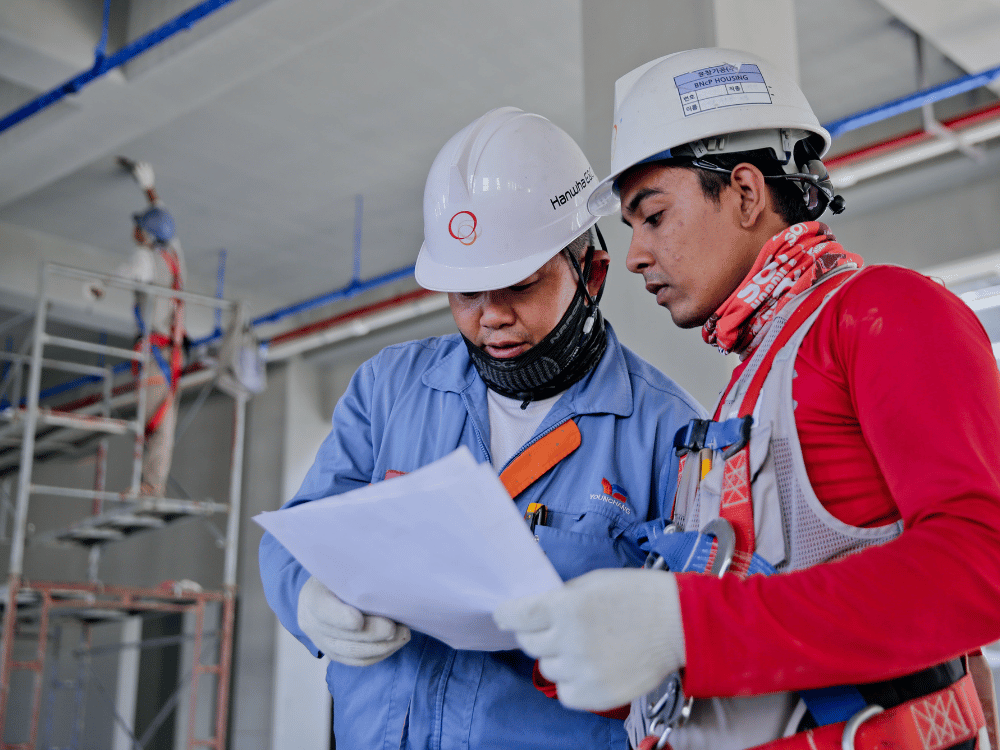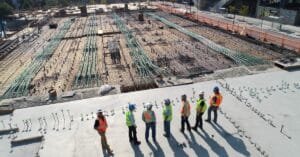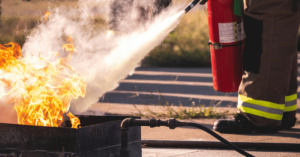Asbestos exposure is a catalyst for asbestosis and the most common cause of work-related deaths globally.
With that in mind, it’s incredibly important to have robust checks in place and understand what to do when you come into contact with the compound.
But who is responsible for preventing your exposure to asbestos? What measures should be in place to mitigate the risk? And how can you enhance your team’s understanding?
TL;DR – Who is Responsible for Preventing Your Exposure to Asbestos?
According to Regulation 4 of the Control of Asbestos Regulations 2012, the building owner or ‘duty holder’ is responsible for managing asbestos in the building.
However, we will go into this in more depth shortly.
The regulations also set out safety obligations for all of the below parties:
- Employers
- Property Owners
- Health and Safety Executive (HSE)
- Local Authorities
Now, let’s dive deeper into asbestos exposure and how the knowledge gained through passing the asbestos awareness course with TSW Training can help improve awareness in your team.
What are the Asbestos Exposure Limits According to the Regulations?
Regulation 2 of The Control of Asbestos Regulations dictates that control limits should be in place where it is not reasonably practicable for the employer to reduce an employee’s exposure to asbestos.
These limits are set at 0.1 asbestos fibres per cubic centimetre of air (0.1 f/cm3) averaged over a four-hour period.
Additionally, Regulation 11 mandates that employers provide suitable PPE and respiration equipment.
However, where contact with asbestos is inevitable, asbestos risk assessments should be in place, and reviews should be completed every 6-12 months.
Plus, in the case of commercial leases, the responsibility for repairs and maintenance falls to the employer. Employers should oversee the implementation of a robust asbestos management system.
6 Steps to Make an Asbestos Management Plan
The Health and Safety Executive (HSE) outlines that an asbestos management plan should map the mitigation procedures for risks posed by asbestos-containing materials (ACMs) on your property.
A robust plan should be built around the six steps:
1. Identify Asbestos
There are different types of asbestos, so knowing how to identify them is a core skill – one that is included in the awareness training course.
However, there are four core types of the compound to be aware of:
- Chrysotile: Also known as white asbestos, this can be found in roofs, ceilings, walls, and floors.
- Amosite: Brown asbestos is more commonly found in cement and insulation.
- Crocidolite: Also found in some cement, blue asbestos is more commonly used in spray form as an insulant or coating.
- Anthophyllite: Less commonly found, anthophyllite is used with other substances to create more forms of insulation.
2. Presume All Materials Contain Asbestos
When trying to certify the presence of ACMs, the first thing to do is check when your building was constructed. If it was built before 2000, you will likely have asbestos present.
If your building’s construction predates 2000, you should assume all materials contain asbestos.
3. Compile an Asbestos Register
The asbestos register forms a crucial part of any asbestos management plan.
A live document, the asbestos register must contain up-to-date information about the existence and condition of asbestos in your building.
A robust register should include details of:
- All known and presumed ACMs on your premises and their types.
- The quantity of asbestos.
- Condition of the ACMs.
- Dates of the original and most recent inspections.
- The potential for each ACM to release dangerous fibres.
- Likelihood of the ACMs becoming disturbed or damaged during day-to-day business activities.
- Details of works necessary or completed.
To assist with future checks and aid condition mapping, you should also think about taking photographs of each ACM. We’d also recommend highlighting any assessment due dates.
4. Conduct Risk Assessments
Like a standard risk assessment, asbestos risk assessments should be scheduled regularly by the employer or building owner and carried out by a competent person or third-party specialist.
You can establish competent people throughout your management team by developing their health and safety knowledge through IOSH or NEBOSH qualifications.
5. Maintain an Asbestos Management Plan
A management plan should not be completed and filed just once. You should be aiming to complete regular reviews of the details therein. Annual checks can help you stay on top of any substance deterioration. These checks should also be referred to before any development works take place.
Non-compliance can result in hefty fines, further punishment, and clear health implications.
For example, a Bradford-based construction company was fined £16,000 in March 2019 for failure to complete relevant assessments before removing ACMs in a shop conversion.
6. Communicate with Those at Risk
Further to the above points, a robust management plan should conclude with communicating identified ACMs to staff.
That feedback should include details of the ACMs, their location, and best practices for working in those areas if removal is not required.
It could also benefit your safety culture to include information on ACM review dates for complete transparency.
Who is Responsible for Preventing Your Exposure to Asbestos?
The building owner is principally responsible for ensuring the clear communication and subsequent management of asbestos in their property.
However, other parties do have roles to play in ensuring safe maintenance duties are completed.
1. Employers
In the case of commercial leases, employers are directly responsible for the management of ACMs.
Business owners are also liable for any hazards or risks posed to workers, customers, members of the public, or other parties who could be visiting the property.
To this end, it is the employer’s responsibility to ensure your business’s asbestos management plan and asbestos register are entirely up to date and reviewed regularly.
In addition, when asbestos is found on a property, employers and building owners are responsible for reporting exposure incidents under RIDDOR laws.
2. Property Owners
When defining who is responsible for preventing your exposure to asbestos, it helps to think of property owners as those who hold liability before employers.
To unpack that a little further, business owners must conduct a risk assessment for asbestos upon purchasing the building. They should then notify any prospective tenants of asbestos before completing lease agreements.
As an extension of this responsibility, owners are also legally required to schedule a risk assessment and notify contractors of ACMs on their property before any work is carried out.
Owners of a glass company in Durham were fined £20,000 when fire alarm installers were not notified of any asbestos risk in the building before completing works.
3. Health and Safety Executive (HSE)
In line with the Health and Safety at Work Act 1974, the HSE outlines that employers must take steps to protect employees from the danger of asbestos. This also applies to the self-employed.
It’s the responsibility of the HSE to investigate any cases of asbestos exposure in the workplace and ensure any removal works or maintenance of asbestos is carried out safely.
In addition, the HSE states that workers should be given appropriate training to work around asbestos. Our asbestos awareness training course can help your business fulfil this requirement.
4. Local Authorities
The use of asbestos in the UK was banned in 1999. This includes the purchase, sale, importation, and export of any materials containing the compound.
Local authorities also work closely with the HSE to enforce asbestos regulations and are the principal enforcement body for buildings in these sectors:
- Retail
- Distribution
- Warehousing
- Leisure industry (such as hotels, pubs, clubs and catering premises)
- Offices
- Nurseries or playgroups
- Care homes
- Privately owned museums
- Places of worship
- Consumer industries
By contrast, when asbestos is being removed from a building, it should only be handled by a licenced disposal site. Your local authority will have information on asbestos disposal sites in the area.
6 Asbestos Removal Rules You Must Know About
When removing asbestos from your building, property owners and employers must abide by a set of crucial rules.
1. Use Licenced Contractors
Large asbestos removal projects should be carried out by licenced contractors.
2. Low-risk Removals
Low-fibre ACMs can be removed without an asbestos removal licence. These include AIB (asbestos insulation boards), textured coatings (Artex) when backing boards are kept intact and resin-based materials like gaskets, friction products, and brake linings.
3. Complete Works With Trained Professionals
When removing low-fibre ACMs, work must be risk assessed first and completed by someone with asbestos awareness training and all essential PPE.
4. Always Carry Out Risk Assessments
Employers should schedule a thorough asbestos risk assessment before removal works are carried out.
5. Dispose of ACMs Safely
Any asbestos removed from your property must be handled and stored at a designated asbestos disposal site.
6. Report Non-compliance
Incidents of non-compliance must be reported to the HSE or your local authority.
Here’s What to Do if You’ve Been Exposed to Asbestos
If you suspect you have been exposed to asbestos in the workplace, consult your General Practitioner (GP) and ask for a note to be kept on file highlighting possible exposure dates.
Where you are unsure whether a substance is an ACM or not, you should stop work immediately and conduct a thorough risk assessment. Return to work only when the existence and risk potential of the ACMs have been defined, and it is considered safe to do so.
Again, the removal of most ACMs should be carried out by trained professionals.
Frequently Asked Questions (FAQs)
Here are some frequently asked questions about who is responsible for preventing your exposure to asbestos.
Is Asbestos Covered by COSHH?
No, although asbestos is considered a dangerous substance, it is not covered under COSHH guidelines. Asbestos isn’t covered under COSHH because it is dangerous enough to have its own set of regulations.
Which Regulations Outline How to Deal with Asbestos?
Regulation 7 of the Control of Asbestos Regulations 2012 outlines that an employer must not undertake any work with asbestos without an appropriate management plan.
It also highlights the responsibilities of building owners, employers, and contractors when working with asbestos.
Who is Responsible for Managing any Asbestos Present in Buildings?
The ‘duty holder’ is responsible for managing asbestos in your property. Generally, a duty holder refers to the business owner. Alternatively, in the instances of commercial leases, the employer takes responsibility.
Conclusion
When considering who is responsible for preventing your exposure to asbestos, the building owner or employee will shoulder most liability.
Asbestos exposure can be extremely damaging to your personal health. But it can also leave lasting effects on a business, both reputationally and financially.
However, owners and employers can improve the quality of their in-house asbestos knowledge and mitigate those risks by completing our asbestos awareness course at TSW Training.














